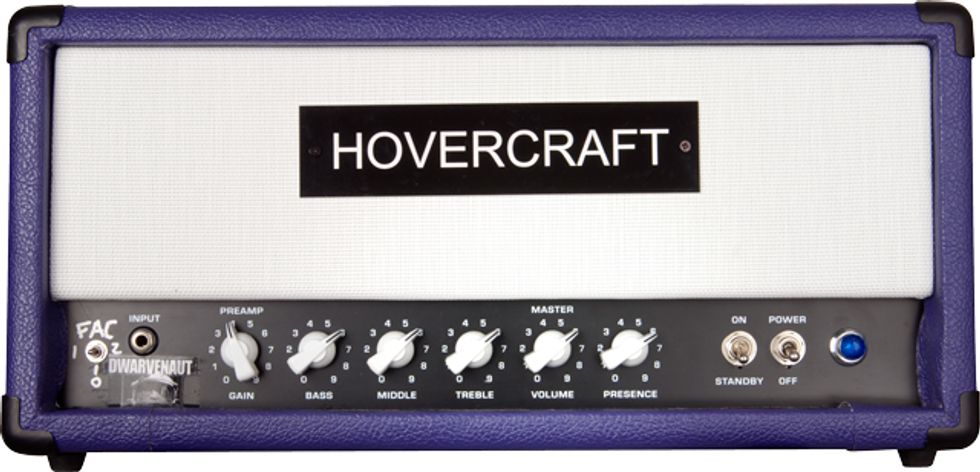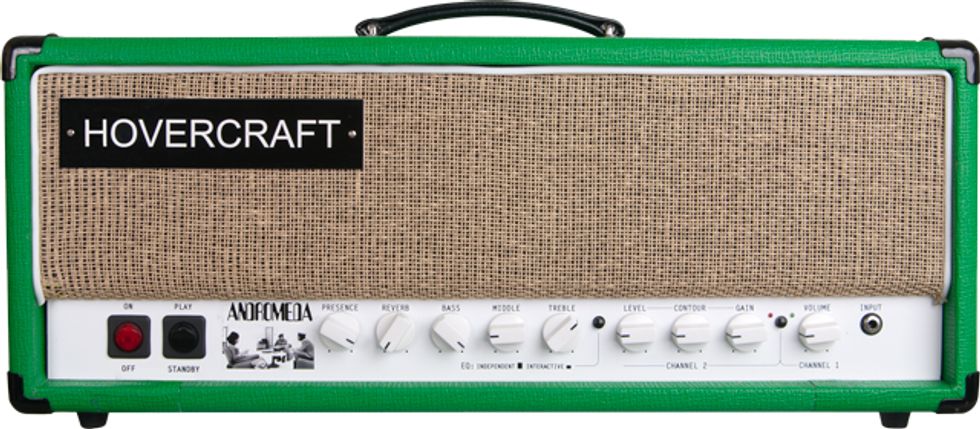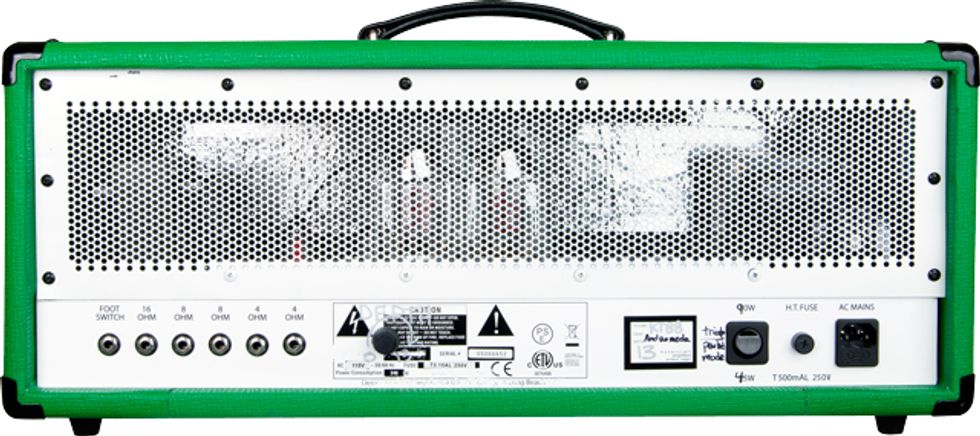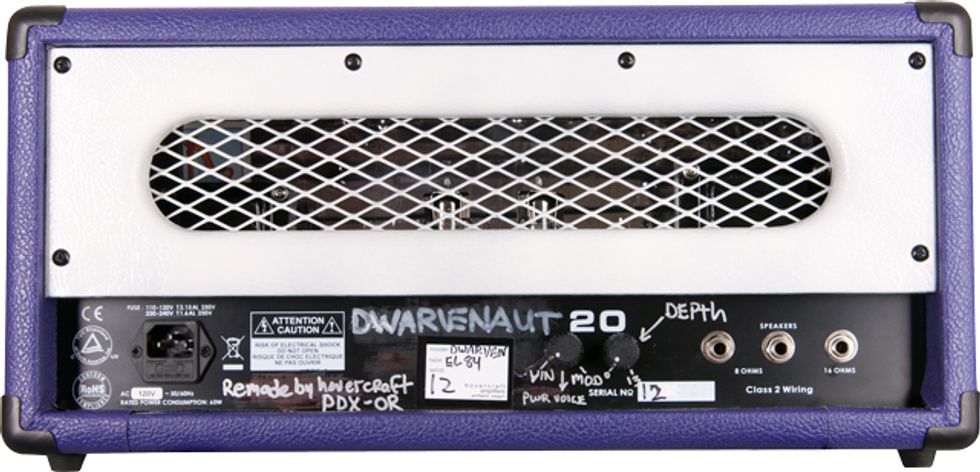Where does gear go to die? You don’t often see a Strat sticking out of a dumpster, or a Marshall lying shattered in a ditch. Most of us probably have at least one guitar, amp, or pedal that’s broken but not beyond repair, sitting on a shelf or in a drawer somewhere. It never goes in the trash bin because we have a hunch that someday the enclosure, neck, or oddball part will come in handy for a project.
Hovercraft Amplification has based its entire business on seeing those thoughts through. The company acquires old, discarded amps and essentially recycles them, attaching different transformers, making changes in the circuit and adding whatever upgrades it takes to transform the old gear into new creations. Some might call this modding, but really it’s rebuilding. And the Dwarvenaut 20 and the Andromeda KT88 are built—or rebuilt—to achieve tones from the most hallowed names in stoner and doom rock. Every amp Hovecraft makes is slightly different, both visually and tonally, and we took an example of each for a test drive.

Rock Reloaded
The Dwarvenaut 20 is an EL84-powered terror influenced by the tones of Orange, Marshall, and Laney. While the circuitry on our review model is clean and well soldered, some aspects of the cabinet’s fit and finish give pause. The cabinet is covered in a really durable purple vinyl—an obvious nod to Matamp—but could have used some more glue around the bottom, front, and back edges where it was loose. The cab’s bottom shielding could have been cut flush with the chassis, too, instead of poking out noticeably along the edges. Obviously these details don’t detract from the amp’s tone, but they could bring an even more professional look to what’s otherwise a really good-looking amplifier.
The 12AX7-powered preamp is designed to cover everything from overdriven Super Lead to extremely high-gain Laney Supergroup tones, and it feeds a 20-watt, dual-EL84 output section that’s tailored for a spongy and wide response reminiscent of vintage Orange OR series amplifiers. Speaking of vintage Orange amps, the Dwarvenaut packs another loving tribute in the form of a FAC-style switch, which gives you the choice of altering the preamp’s midrange curve in three different modes. Shaping the tone is an otherwise straightforward affair, relying on individual controls for presence, treble, middle, bass, preamp gain and master volume. The rear panel offers dual 8 Ω outputs, a single 16 Ω output, a knob for blending between strident modern and squishy vintage voicings, and a dedicated depth control for getting bigger tones at low volumes.
Heavier Than Thou
Simply put, the tones produced by the Dwarvenaut are huge and it pushes much more air than you’d expect. But it also excels at dishing out big tones at lower volumes. At lower gain settings the amp still demonstrates nice attack and quick response in the lows. The midrange voicing is very present, but round and full in a way that prevents it from growing grating at louder volumes.
Ratings
Pros:
Dynamic and responsive at low and mid-gain levels. Lots of volume on tap.
Cons:
Loose vinyl in some areas. Only one channel.
Tones:
Ease of Use:
Build:
Value:
Street:
$550
Company
hovercraftamps.com
Hitting the strings harder when the gain control is at its sweet spot—about 40%—pushes the amp beyond crisp Hiwatt-like tones to heavier Orange-style overdrive, while loosening the low end and adding more presence to the attack. The amp also reacts extremely well to changes from the guitar’s onboard controls, and you can drop the guitar’s volume knob for velvety vintage drive after setting the amp up for face-ripping fuzz. If you lose some high end in the process, the FAC-style switch works wonderfully for toning down preamp aggression and giving the sound more room to breathe with less clutter.
The Dwarvenaut’s more vicious tones aren’t for the faint of heart. Pushing the gain past noon and maxing the depth control makes it snarl and growl menacingly, with an ample low end that’s bigger sounding than most amps in its power class. At high-gain levels the amp is fuzz-like, infusing the highs and mids with a hairy edge. When the amp is set this way, some of its coolest and most distinctive tones can be achieved by cranking the treble and presence and dropping the mids to around 8 o’clock. This yields a retro, Tonebender-on-steroids tone that sounds eerily close to the intro of Fu Manchu’s “Evil Eye.” It’s a tone that’s nothing like the established tones that traditionalists go gaga over, but it has an interesting character that stands out.
The Verdict
Few low-wattage amps succeed at capturing the monstrous sound of modern doom and fuzzy stoner rock. The Dwarvenaut, however, skirts the line between nailing those tones and those of more conventional, softer tones—making it a heavy amp with a voice of its own. Fit and finish could use some improvement, but for the money it’s a satisfying and useful amplifier.

A Gift From the Stars
The 90-watt Andromeda is one of the most powerful amplifiers in Hovercraft’s arsenal. Our review model came covered in a green Matamp-style vinyl with a wicker-covered faceplate, and fit and finish were much better than on the Dwarvenaut.
The amp features a global tube reverb and two very different channels. The first has a circuit inspired by the cleans and low grit of a vintage Orange OR80, and uses a traditional tone stack of treble, middle, and bass controls, along with presence and volume knobs for non-master usage.
The second channel has a vicious voice and a very high-gain Matamp-style overdrive—using separate preamp gain and volume controls that work with a contouring control to shift midrange frequencies. A depth control on the back dials up or pulls back the amp’s extreme sub-sonic frequencies.

The second channel includes a Baxandall tone stack, which is more commonly found in hi-fi equipment than in guitar amps. Yet many engineers—including those at Ampeg and Orange—find that a Baxandall circuit can produce a wider array of tones with more control than the traditional bass/mid/treble, primarily because frequency bands don’t overlap one another. Baxandall-equipped amps, such as the Ampeg V4, Sunn Model T, and Orange OR120 were key influences in the Andromeda’s conception.
Both channels use five 12AX7s, which in turn rout the signal into a pair of KT88s for room-shaking power. And if its blistering 90 watts is too much for you, there’s a half-power switch on the back that drops the output to 45 watts.
Ratings
Pros:
Vibrant, powerful and detailed overdrive. More than enough power for the loudest stoner rock.
Cons:
Very quick and present attack qualities might be too quick and present.
Tones:
Ease of Use:
Build:
Value:
Street:
$850
Company
hovercraftamps.com
A Screaming Stoner Witch
The Andromeda’s tone, feel, and character shout “power.” And because of the ample headroom provided by its KT88-fueled power section, the cleans are quite heady and robust for most applications. The Andromeda’s clean channel provides a fairly warm low-end foundation for flatpicking and general clean riffing, even if the highs and mids don’t quite attain the smoothness of, say, an Orange OR80. The KT88s add a quick and sharp quality to the attack, however, which means more cut and authority than most EL34- and 6L6-based amps. They’re also a factor in shaping the first channel’s highs and midrange, which are unrelenting and brash. The tone can be softened a bit by switching to 45 watts and bringing up the preamp gain a little.
The real star of the show is the Andromeda’s second channel, which excels at dishing out monstrous overdrive with punch and character. A Les Paul is a perfect pair for the Andromeda, and together they deliver fire-breathing lead tones, thick mids, and pumping lows. Hovercraft’s interpretation of the Baxandall circuit is a great match for this channel, and keeps the bass, midrange, and treble frequencies focused at the most extreme gain settings.
The Verdict
The Andromeda wears its influences on its sleeve. And for all of its power and headroom, it sometimes feels like a one-trick pony. That’s not really a knock against the Andromeda—it does what it does very well, though it’s probably not where you want to turn for the perfect blues or shred rock tone. But if you’re after a cheaper alternative to the vintage amps that best defined the loud-and-proud roaring of decades ago, it’s more than worth a listen.








![Rig Rundown: Russian Circles’ Mike Sullivan [2025]](https://www.premierguitar.com/media-library/youtube.jpg?id=62303631&width=1245&height=700&quality=70&coordinates=0%2C0%2C0%2C0)

















